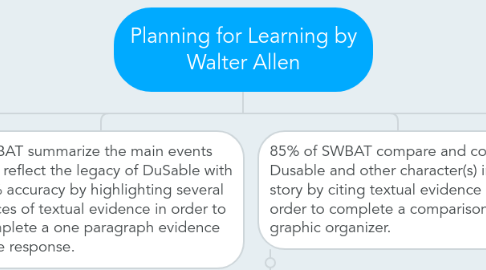Planning for Learning by Walter Allen
by walter allen

1. Standard CCSS.ELA-LITERACY.RL.7.1 Cite several pieces of textual evidence to support analysis of what the text says explicitly as well as inferences drawn from the text.
1.1. 7th Grade ELA
2. SWBAT describe Dusable's personality with 85% accuracy by citing pieces of evidence and drawing inferences in order to complete a character map
2.1. Big Idea: Ones actions can stem from his own personality or the influence from another.
2.2. Scaffold: Teacher will provide students with a list of character traits to pick from in order to assist in generating a list that reflects DuSable's personality.
2.3. Key Factors: The students don't know how to identify personalities and character traits by judging the actions alone but they do understand what an action is and can match an action with a character trait if they have a word bank of character traits to choose from.
3. SWBAT summarize the main events that reflect the legacy of DuSable with 85% accuracy by highlighting several pieces of textual evidence in order to complete a one paragraph evidence base response.
3.1. Big Idea: The things you do for yourself are gone when you're gone; but the things you do for others remain as you're legacy.
3.2. Scaffold: Teacher will demonstrate how to construct an evidence based response. The teacher will introduce the topic, events, evidence, explanations, and a conclusion. Finally, students will use this as a paradigm to follow.
3.3. Key Factors: Students possess the skills to cite textual evidence, however, they lack the organization skills that are need to write a clear concise evidence based response. The scaffold will ensure that students' responses contain the proper components.
4. 85% of SWBAT compare and contrast Dusable and other character(s) in the story by citing textual evidence in order to complete a comparison graphic organizer.
4.1. Big Idea: Some people have similar visions but different means of viewing them.
4.2. Scaffold: Teacher will provide students with a venn diagram to categorize the similarities and differences. Next, the teacher will demonstrate how to properly fill out the venn diagram by using a example excerpt.
4.3. Key Factors: The students lack the organizational skills to clearly present the similarities and differences, thus the scaffold helps them distinguish the two.
5. SWBAT explain the challenges of Chicago that made it hard to survive with 95% accuracy by citing several pieces of textual evidence in order to participate in a socratic seminar.
5.1. Big Idea: The challenges of life may exploit ones weaknesses and reveal the strengths of another
5.2. Scaffold: Students will watch a video of a well organized socratic seminar via YouTube.
5.3. Key Factors: The students usually outburst their opinions and answers. They usually also don't have questions or rebuttals for their peers. However, the students love to talk and engage with each other. This scaffold will show them how to engage in a thought-provoking organized manner, while allowing everyone to speak and be heard.
6. SWBAT determine the main idea of "Dusable choices and challenges" by paraphrasing and citing several pieces of textual evidence in order to complete a one paragraph objective summary with 95% accuracy.
6.1. Big Idea: The picture is very clear when you're looking at it through the lenses of your own glasses.
6.2. Scaffold: Teacher identifies the first 2 topic sentences in the first 2 paragraphs along with the supporting details for those topic sentences. The topic sentence is also the main idea of that paragraph. It tells the reader what the purpose of the paragraph is. Next, the teacher will demonstrate how to paraphrase, by reading the first two paragraphs and then putting them into his own words. The teacher will then exemplify how to construct an objective summary using the 2 topic sentences and supporting details from those 2 paragraphs. Finally, the students will use the examples of the first 2 paragraphs as a guide in order to replicate the process with the remaining parts of the text.
6.3. Key Factors: Students can't identify a topic sentence and don't understand the purpose of it. However, students do know how to paraphrase but may not know how to convert 2 topic sentences with supporting details into their own words. Thus the scaffold will be used to aide them. Lastly, students will be able to convey the main idea by using the culminating of information organized in a objective summary which they are already familiar with.


